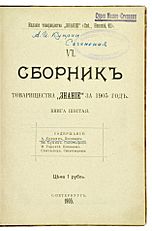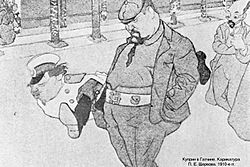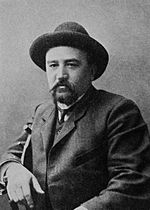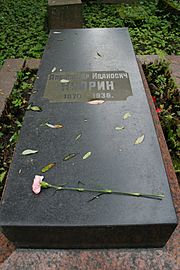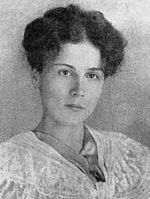Aleksandr I. Kuprin facts for kids
Quick facts for kids
Aleksandr Kuprin
|
|
|---|---|

Kuprin in 1910s
|
|
| Born | 7 September [O.S. 26 August] 1870 Narovchat, Penza Governorate, Russian Empire |
| Died | 25 August 1938 (aged 67) Leningrad, Soviet Union |
| Occupation | Novelist, short story writer,playwright, journalist |
| Citizenship | Russia |
| Literary movement | Naturalism |
| Notable works | Olesya (1898) The Duel (1905) The Garnet Bracelet (1911) Yama: The Pit (1915) |
| Notable awards | Pushkin Prize |
| Spouse | Maria Karlovna Davydova (1902—1907) Yelizaveta Geinrikh (1907—1938) |
| Children | Lidia Kuprina (1903–1924) Ksenia Kuprina (1908–1981) |
| Signature | |
 |
|
Aleksandr Ivanovich Kuprin (Russian: Александр Иванович Куприн; 7 September [O.S. 26 August] 1870 – 25 August 1938) was a famous Russian writer. He is well known for his novels The Duel (1905) and Yama: The Pit (1915). Other popular works include Moloch (1896), Olesya (1898), and The Garnet Bracelet (1911). The Garnet Bracelet was even made into a movie in 1965.
Contents
Early Life and Education
Aleksandr Kuprin was born in 1870 in Narovchat, Russia. His father was a government official. His mother came from a noble Volga Tatar family. Aleksandr had two older sisters.
In 1871, when he was just one year old, his father died. A few years later, Aleksandr and his mother moved to a home for widows in Moscow. This time in his life is shown in his story "A White Lie" (1914). In 1876, he started at the Razumovsky boarding school. He found it a challenging place. However, he was popular among his friends because he was a great storyteller.
Becoming a Cadet: 1883–1887
In 1880, Kuprin joined the Second Moscow Military High School. He then moved to the Cadet Corps in 1882. He wrote about this time in stories like "At the Turning Point" (1900). Even though it was tough, he became interested in literature there. He also started writing poetry.
Most of Kuprin's early poems were written between 1883 and 1887. He also translated poems from other languages. One of his interesting early poems was "Dreams." He wrote it in 1887, when he was 17.
Military Service: 1888–1894
In 1888, Kuprin left the Cadet Corps. He went to the Alexander Military Academy in Moscow. In 1890, he graduated as a sublieutenant. He was sent to the 46th Dnieper Infantry Regiment. He spent the next four years there.
Starting a Literary Career
In 1889, Aleksandr Kuprin met Liodor Palmin, a well-known poet. Palmin helped Kuprin publish his first short story, "The Last Debut." This story was based on a real event: the death of a singer on stage.
It took three years for Kuprin to publish his second story, "Psyche," in 1892. This story, and "On a Moonlit Night," explored the line between imagination and reality.
During his military service, Kuprin published a short novel, In the Dark (1893). He also wrote several short stories. "The Inquiry" (1894) was his first story to get a lot of attention. It was about army life. This story led to a series of other army-themed stories.
Kuprin left the army in 1894. He felt unhappy with military life. After leaving, he traveled around the South-West of the Russian Empire for five years. He tried many different jobs. These included working in dental care, surveying land, acting, and being a circus performer. Each of these experiences later appeared in his stories. He also spent a lot of time reading and learning on his own.
In 1894, Kuprin arrived in Kyiv. He started working for local newspapers. He believed a good journalist needed "courage, boldness, a wide view, and amazing memory." He felt he had these qualities. He also wrote for newspapers in other cities like Odessa.
In 1896, Russkoye Bogatstvo published Moloch. This was Kuprin's first major work. It looked at the fast growth of Russian capitalism.
Kuprin also wrote short pieces about different places and people. In March 1896, his first book, Kyiv Types, was published. In 1897, his second collection, Miniatures, came out. One of his circus stories, "Allez!", was highly praised by Leo Tolstoy. These early works helped Kuprin grow as a writer.
In 1897, Kuprin worked as an estate manager in Volhynia. Then he went to the Polesye area. He said this time gave him his "most powerful and useful impressions." He learned a lot about the Russian language and landscape there. Three stories from his "Polesye Cycle" were published between 1898 and 1901. These included "The Backwoods" and his well-known love story Olesya. Both Moloch and Olesya greatly helped his writing career. In 1901, he moved to Saint Petersburg.
Life in Saint Petersburg: 1901–1904
In Saint Petersburg, Kuprin was at the heart of Russian culture. He became friends with famous writers like Anton Chekhov and Ivan Bunin. He often asked Chekhov for advice. He also became good friends with Maxim Gorky.
In 1901, Kuprin joined the Moscow Sreda (Wednesday) literary society. This group included young realist writers like Gorky and Bunin. In 1902, Kuprin married Maria Karlovna Davydova. She became the editor of the popular magazine Mir Bozhy. Kuprin soon became the head of the fiction section for her magazine.
In 1903, a collection of eight of Kuprin's stories was published. Leo Tolstoy praised the book for its lively language. Critics also liked it, saying Kuprin's style was similar to Chekhov's and Gorky's. Gorky himself called Kuprin one of the top Russian authors.
Even with his success, Kuprin's first years in Petersburg were hard. Working for the magazine left him little time to write his own stories. People also spread rumors that his success was only because of his wife's family.
Between 1902 and 1905, Kuprin wrote fewer stories. However, their quality was much higher. He started writing about the struggles of ordinary people. This followed a strong tradition in Russian literature. Some notable stories from this time include "At the Circus" (1902), "The Swamp" (1902), and "The Jewess" (1904). "The Jewess" showed his deep sympathy for Jewish people. This was important at a time when attacks on Jewish communities were common in Russia.
The Duel and Its Impact (1905)
In 1904, Kuprin began writing The Duel. He had thought about this novel since his time in the army. It was about the "horror and boredom of army life." The novel was published on May 3, 1905. Writing it was a very important experience for Kuprin. He wanted to "challenge the tsarist army to a duel" with his book.
The Duel became a huge literary success in Russia. Over 45,000 copies were sold in 1905, which was a lot for that time. The book caused much debate until 1917. Some critics saw it as a challenge to the government. Others said it was an attack on the army. The Duel made Kuprin famous and secured his place in Russian literature. The first English version was published in London in 1907.
After the 1905 Revolution: 1905–1913
After the 1905 Revolution, Kuprin openly criticized the government. He even tried to join the sailors on the battleship Potyomkin, which had a mutiny in 1905. Because of this, the secret police watched him. In his story "Events in Sevastopol," he described the destruction of a ship he saw. He also helped rescue sailors from the burning ship.
Some of his well-known stories from this time include "Dreams" and "Junior Captain Rybnikov" (1906). The latter was about a Japanese spy. Gorky praised it. "Gambrinus" (1907) was another important story.
From 1905 onwards, Kuprin also took part in many non-writing activities. He flew in an air balloon and went diving in the Black Sea. He also flew in an airplane. In 1907, he divorced his first wife. He then married Yelizaveta Geinrikh in 1907. Their daughter Ksenia Kuprina was born in 1908.
In 1908, Kuprin's friendship with Gorky became difficult. Kuprin left Gorky's publishing company. Other works from this time include "Emerald" (1907), a famous animal story. "Sulamith" (1908) was a story about 'eternal love'. The Garnet Bracelet (1911) is a well-known novella about hopeless love. In 1909, Kuprin and Bunin jointly received the Pushkin Prize.
The Pit (1909)
In 1908, Kuprin started working on The Pit. This was his most ambitious work. The first part caused a lot of discussion. Some critics, including Leo Tolstoy, found it too realistic.
The Pit was Kuprin's last major work. Many felt it marked a decline in his writing. His best-known stories from 1912–1914 were "Black Lightning" and "Anathema." In 1911, he moved his family to Gatchina, near Saint Petersburg.
When World War I began, Kuprin opened a military hospital in his home. He also visited the Western front. In November 1914, he was called up as a reserve officer. He commanded an infantry company in Finland until May 1915. He had to leave due to poor health. This meant he could not be a war correspondent, which he had wanted to be.
The February Revolution happened when Kuprin was in Helsinki. He was excited about the end of the tsarist rule. He started editing a newspaper called Svobodnaia Rossiya (Free Russia).
The October Revolution made Kuprin's political views unclear. He wrote articles where his feelings about the new government were mixed. He saw the historical importance of the Bolshevik Revolution. He admired Lenin as "an honest and courageous man." However, he also criticized some of the Bolshevik policies. He felt they threatened Russian culture and caused suffering to peasants. In June 1918, Kuprin was briefly arrested for an article critical of the government.
Years in Emigration
In October 1919, the White Army took Gatchina. Kuprin worked for a newspaper published by the White Army for a short time. As the White Army retreated, Kuprin traveled with his family. They went through Estonia and Finland. In July 1920, they arrived in Paris, France.
Kuprin spent the next seventeen years in Paris. This period saw a decline in his writing. He was sad to be away from Russia. His family also faced poverty. This made writing even harder for him. "The more talented a man is, the harder is for him life without Russia," he told a reporter in 1925.
His longing for Russia meant his later works often looked back at his past. He wrote about familiar themes and personal experiences. A visit to southwest France in 1925 inspired "Crimson Blood" (1926), about a bullfight. He also wrote "The Blessed South" (1927) about France. Later, he wrote sketches about cities after visiting Belgrade in 1928. His three main works from his time in Paris were The Wheel of Time (1929), the autobiographical The Junkers (1932), and the romantic "Jeannette" (1933).
Return to Russia and Death
By 1930, Kuprin's family was struggling financially. His writing earnings were small. His health also began to fail. His eyesight got worse after 1932. His wife tried to start businesses, but they failed. Returning to the Soviet Union seemed like the only solution. In late 1936, he decided to apply for a visa.
On May 29, 1937, the Kuprins left Paris for Moscow. They were met by writers' groups and stayed in a hotel. In June, they moved to a country house near Moscow. Kuprin received medical care there. In December, he and his wife moved to an apartment in Leningrad.
His years in Paris had weakened his health. He had become an old man. His friend Nikolay Teleshov visited him and found him very changed. He was confused and weak. Other writers also noted how ill he was.
Kuprin's return meant his works were published in the Soviet Union. However, he wrote almost nothing new. In June 1937, a piece of his memoirs was published. In October, a sketch called "My Native Moscow" came out. Some accounts say he was happy to be back in Russia. Others say he felt like a stranger in his home country.
In January 1938, Kuprin's health got worse. By July, he was very ill. He had kidney problems and then developed esophageal cancer. Surgery did not help. Aleksandr Kuprin died on August 25, 1938. He was buried in Volkovo Cemetery in Leningrad two days later.
Family Life
In February 1902, Kuprin married Maria Karlovna Davydova. She was the adopted daughter of Alexandra Davydova, who edited the magazine Mir Bozhy. Maria Karlovna took over the magazine after her mother died. Kuprin then became the head of the fiction section. They had one daughter, Lidia (1903–1924).
In 1907, the couple divorced. Maria Davydova later wrote a book of her memories.
Kuprin's second wife was Yelizaveta Geinrikh (1882–1942). She was a nurse and later a governess for Lidia. In 1907, they married and settled in Gatchina. Their daughter Ksenia Kuprina was born in 1908. Their second daughter, Zinaida, was born in 1909 but died young in 1912. After the Kuprins returned to Russia, Yelizaveta worked on publishing her husband's writings. She died in 1942 during the Siege of Leningrad.
Ksenia Kuprina (1908–1981) became a model and actress in the late 1920s. She appeared in 11 films. She returned to the USSR in 1958. There, she worked as an actress, translator, and writer. Her book of memories, My Father Kuprin, came out in 1978.
Legacy and Impact
Kuprin became famous for his novel The Duel (1905). Other writers like Anton Chekhov, Maxim Gorky, and Leo Tolstoy praised him highly. Tolstoy even called him a true successor to Chekhov. Kuprin lived at a time when many writers were trying new styles. However, he focused on writing about things he had experienced himself. His characters are often the next generation after Chekhov's sad characters.
Vladimir Nabokov called him "the Russian Kipling" because of his stories about people seeking adventure. These characters were often "nervous and easily hurt." Throughout the 20th century, Aleksandr Kuprin remained "one of the most widely read classics in Russian literature." Many films have been made based on his works. This is partly because of his vivid stories about ordinary people and sad love. His descriptions of military life also make him a writer for all times and places.
A minor planet named 3618 Kuprin was discovered in 1979. It was named after him.
Selected Works
Novels
- The Duel (Поединок, 1905)
- The Pit (Яма, 1909–1915)
- The Wheel of Time (Колесо времени, 1929)
- Junkers (Юнкера, published 1933), an autobiographical novel
Novellas
- In the Dark (Впотьмах, 1893)
- Moloch (Молох, 1896)
- Olesya (Олеся, 1898)
- Sulamith: A Romance of Antiquity (Суламифь, 1908)
- The Garnet Bracelet (Гранатовый браслет, 1911)
Short Stories and Sketches
- "The Last Debut" (Последний дебют, 1889)
- "Psyche" (Психея, 1892)
- "On a Moonlit Night" (Лунной ночью, 1893)
- "The Inquiry" (Дознание, 1894)
- The Kiev Types (Киевские типы, 1896, a collection of sketches)
- Miniatures (Миниатюры, 1897, short story collection)
- "At the Circus" (В цирке, 1902)
- "The Horse Thieves" (Конокрады, 1903)
- "Captain Ribnikov" (Штабс-капитан Рыбников, 1906)
- "The River of Life" (Река жизни, 1906)
Images for kids
-
Petersburg, Kuprin (right) with friend, opera singer Fyodor Chaliapin. Photo by K. Bulla (1911)
See also
 In Spanish: Aleksandr Kuprín para niños
In Spanish: Aleksandr Kuprín para niños



